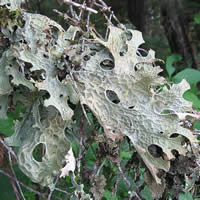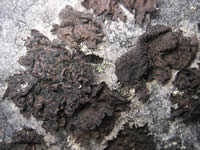USDA Forest Service Celebrating Wildflowers
|
|
|
 |
|
Lichen HabitatLichens have specific requirements for their habitats. Although they can occur on a variety of substrates, each substrate must have the individual components in the right amounts that growing lichen needs. These requirements are: water, air, nutrients, light, and substrates.
WaterBecause lichens do not have a waxy cuticle like plants, they cannot conserve water during drought periods. On the other hand, lichens can absorb everything through their cortex, including water and water vapor. Many lichens are found in foggy areas like the coast, but not farther inland simply because there is not enough water in the air to support them. When lichens are wet, they "turn on" and start photosynthesizing and growing. When lichens are dry, they "turn off", become brittle and go dormant. This process is known as "poikilohydry", and other organisms such as mosses and liverworts operate in the same way. The simplest way to tell if lichen is dormant or growing is by looking at its color. The darker black or brighter green lichen is, chances are that it is photosynthesizing. Of course, if it is wet and pliable, that is a good indication too. If lichen looks pale and is dry and brittle, then it is dormant and waiting for the next rain or fog event before it starts photosynthesizing. AirLichens need clean, fresh air to survive. They absorb everything through their cortex. From beneficial nutrients to harmful toxins, lichens absorb it all. They also absorb water in the air, which is why so many are found in fog belts along oceans and big lakes. Look around the big cities of the world. What do you see? Not very many lichens, that’s for sure. Very few lichens can survive near factories, next to highways, and other sources of pollution. The ones that do survive have a higher tolerance to the pollutants in the air, like heavy metals and acid rain. Check out the National Lichens & Air Quality Database and Clearinghouse website to see how pollution affects lichens and how people are using that information.
NutrientsJust like all living things, lichens need nutrients to survive and grow. The main nutrients include nitrogen, carbon, and oxygen. Nitrogen is especially important since it is necessary for the production of proteins and organic acids, and not just for lichens, but for life on this planet. Lichens, like plants, have difficulty retrieving nitrogen for their use. That is why cyanobacteria are so useful. Like plants, lichens use cyanobacteria to "fix" nitrogen so it can be used. Fixing nitrogen is the process of changing unusable nitrogen into a usable form of nitrogen. Plants like legumes and rye grass use cyanobacteria to fix nitrogen from the soil. Lichens use cyanobacteria to fix nitrogen from the air.
LightSimilar to plants, all lichens photosynthesize. They need light to provide energy to make their own food. More specifically, the algae in the lichen produce carbohydrates and the fungi take those carbohydrates to grow and reproduce. Different lichens need different amounts of light. That is why you will find lichens on exposed rock and desert soils, as well as on a leafy tree or in its shadow on the mossy ground below. The color of lichen is also dependent on the amount of light it receives. For example, Lobaria pulmonaria is normally in a shaded environment, yet when it grows in an exposed environment, the color is different, usually darker, and browner. Different species that adapt to brighter, hotter environments are generally more pigmented. This could be a mechanism of the fungus to protect the algae from getting too much light and burning out. SubstratesLichens need homes too! Every lichen lives on top of something else. The surface of that "something else" is called a substrate. Just about anything that holds still long enough for a lichen to attach to and grow is a suitable substrate. Trees, rocks, soil, houses, tombstones, cars, old farm equipment and more can be substrates. The most common natural substrates are trees, rocks, and soil. Having lichens growing on your rocks, trees and ground around your property is a good thing. That means the air you breathe in is healthy and clean. Although lichens can cause some damage to buildings and man-made structures, it is a very slow process and does not endanger those substrates. Soil is another important substrate for lichens. It provides moisture, nutrients, space to grow, and depending on the location, shelter as well. One unique habitat lichens can colonize is dune systems. If stable for a long enough time, shifting sands can be "held down" by soil crusts, allowing other communities to establish themselves over the top. Soil crusts consist of cyanobacteria, mosses, and lichens. Be careful, though. Once these soil crusts are disturbed, they do not come back for many years and the process has to start over again. The shifting sands themselves pose a risk by blowing over the crust communities and covering them up, preventing light from getting to the organisms underneath and killing them. |
|
| NOTE: PDF format links require the Adobe Acrobat Reader to view. | |
| top | Disclaimers | FOIA | Privacy Policy | Quality of Information | Photo Credits & Use |
Location: http://www.fs.fed.us/wildflowers/interesting/lichens/habitat.shtml
Last modified: Tuesday, 24-Jun-2008 21:54:36 EDT






